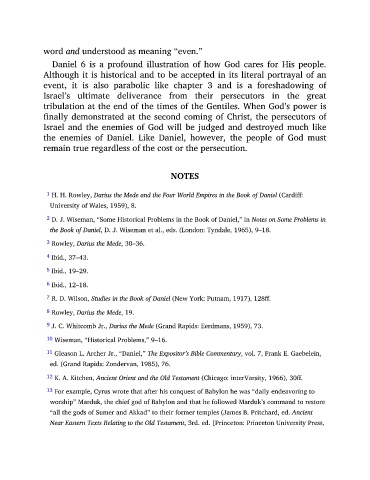Page 173 - Daniel
P. 173
word and understood as meaning “even.”
Daniel 6 is a profound illustration of how God cares for His people.
Although it is historical and to be accepted in its literal portrayal of an
event, it is also parabolic like chapter 3 and is a foreshadowing of
Israel’s ultimate deliverance from their persecutors in the great
tribulation at the end of the times of the Gentiles. When God’s power is
finally demonstrated at the second coming of Christ, the persecutors of
Israel and the enemies of God will be judged and destroyed much like
the enemies of Daniel. Like Daniel, however, the people of God must
remain true regardless of the cost or the persecution.
NOTES
1 H. H. Rowley, Darius the Mede and the Four World Empires in the Book of Daniel (Cardiff:
University of Wales, 1959), 8.
2 D. J. Wiseman, “Some Historical Problems in the Book of Daniel,” in Notes on Some Problems in
the Book of Daniel, D. J. Wiseman et al., eds. (London: Tyndale, 1965), 9–18.
3 Rowley, Darius the Mede, 30–36.
4 Ibid., 37–43.
5 Ibid., 19–29.
6 Ibid., 12–18.
7 R. D. Wilson, Studies in the Book of Daniel (New York: Putnam, 1917), 128ff.
8 Rowley, Darius the Mede, 19.
9 J. C. Whitcomb Jr., Darius the Mede (Grand Rapids: Eerdmans, 1959), 73.
10 Wiseman, “Historical Problems,” 9–16.
11 Gleason L. Archer Jr., “Daniel,” The Expositor’s Bible Commentary, vol. 7, Frank E. Gaebelein,
ed. (Grand Rapids: Zondervan, 1985), 76.
12 K. A. Kitchen, Ancient Orient and the Old Testament (Chicago: interVarsity, 1966), 30ff.
13 For example, Cyrus wrote that after his conquest of Babylon he was “daily endeavoring to
worship” Marduk, the chief god of Babylon and that he followed Marduk’s command to restore
“all the gods of Sumer and Akkad” to their former temples (James B. Pritchard, ed. Ancient
Near Eastern Texts Relating to the Old Testament, 3rd. ed. [Princeton: Princeton University Press,

